Sassi di Matera, Basilicata
The Sassi di Matera are cave dwellings carved out of rock in and around the ancient city of Matera, located in the Basilicata region of southern Italy. These dwellings date back to the Paleolithic Era and represent the earliest human settlements in Italy. The Sassi are significant for their historical and architectural value and have been recognized as a UNESCO World Heritage Site.
The Sassi were home to impoverished residents but starting in the 1950s and continuing again through the 1980s, the Italian government relocated the inhabitants and restored the area. Now, the Sassi area in Matera has been revitalized into a hipster and cultural tourist hub with cafes, bars, museums, and art galleries. And while you’re enjoying the sights, don’t miss out on learning about Italian food culture.

The Trulli of Alberobello, Puglia
The Trulli of Alberobello are limestone huts located in the Puglia region of southern Italy. These structures were built using a prehistoric construction technique of stacking stones without using mortar. The Trulli are recognized by their conical roofs with whitewashed markings.
The Trulli started as storage sheds and evolved into permanent homes. Today, the more than 1,000 Trulli in Alberobello are a UNESCO World Heritage Site, reflecting the architectural tradition. The town is now a hot and trendy area. Italy’s spirit is felt through its food, architecture, culture and the many Italian inventions that have shaped the world.

Trulli of Alberobello, Puglia, Italy
Pompeii, Naples
Pompeii is an ancient Roman city located near Naples in Southern Italy. It was buried under volcanic ash and pumice following the eruption of Mount Vesuvius on August 24, 79 AD. The eruption preserved Pompeii. At its peak, Pompeii was a bustling town of 15,000 people. Today, the site is a UNESCO World Heritage Site and one of Italy’s most popular tourist destinations, attracting millions of visitors each year who come to explore the well-preserved ancient ruins.

Pompeii, Naples, Italy
Castel Sant’Angelo, Rome
Castel Sant’Angelo was built in the capital city as the tomb for Emperor Hadrian and his family. Later it became a fortress and then the papal refuge where Popes hid during sieges. They connected Castel Sant’Angelo to St. Peter’s Basilica via the Passetto di Borgo, a secret passageway.
During the Renaissance, Castel Sant’Angelo became a prison. Today, it serves as a museum presenting the history and transformation of this famous landmark.
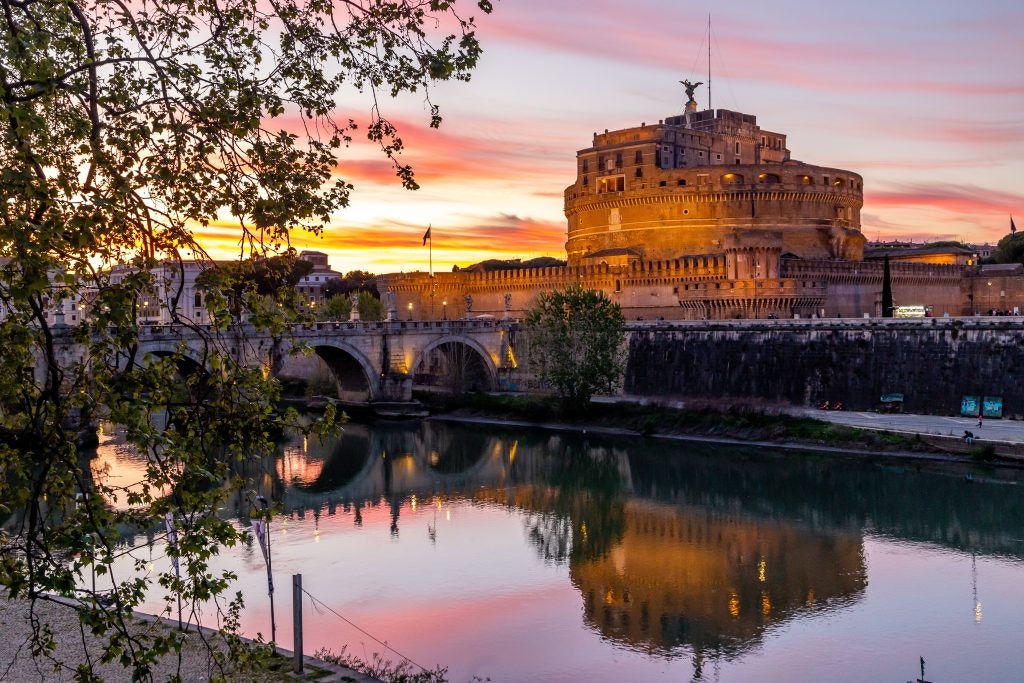
Castel Sant’Angelo in Rome at sunset
The Colosseum, Rome
The Colosseum is one of Italy’s most iconic landmarks and one of the most searched buildings in the world. Construction of the Colosseum began in 72 AD under Emperor Vespasian and was completed eight years later by his son, Emperor Titus. This massive amphitheater could hold over 50,000 spectators who gathered to watch gladiatorial battles, animal hunts, and public executions.
The name ‘Colosseum’ is derived from the nearby Colossus of Nero, a giant statue near the amphitheater. Despite damage from earthquakes and stone robbers, the Colosseum remains an iconic symbol of the Roman Empire and its legacy. See Italy from North to South with Rustic Pathways.

One of the most famous buildings in Italy, The Colosseum in Rome at night
Trevi Fountain, Rome
The Trevi Fountain in central Rome is a famous landmark in Italy. The Baroque style fountain was designed by Nicola Salvi and depicts the sea god Neptune surrounded by tritons and sea horses.
Legend has it that if you toss a coin over your shoulder into the Trevi Fountain, you are destined to return to Rome. This tradition has become so popular that the fountain now collects over a million dollars in coins each year, all of which are donated to help support Rome’s poor.

Trevi Fountain in Rome
Roman Forum, Rome
The Roman Forum was the center of life in ancient Rome. The Roman Forum is a complex of ruins that once housed government buildings, temples, and markets in the Roman Empire.
Now, the Roman Forum is one of the most visited sites in the world. Wander the Roman Forum and imagine that the ruins were once the historic center of an ancient city.

The Roman Forum, Rome, Italy
The Pantheon, Rome
The Pantheon in Rome is an ancient Roman temple famous for its large dome and central oculus. It was built by Marcus Vipsanius Agrippa in 27 BC and rebuilt by Emperor Hadrian in 126 AD. It is one of the best-preserved and most famous monuments of ancient Rome. Now it is a church and a major tourist attraction in Rome’s historical city center. The Pantheon’s dome influenced The U.S. Capitol Building and The Jefferson Memorial in Washington DC.
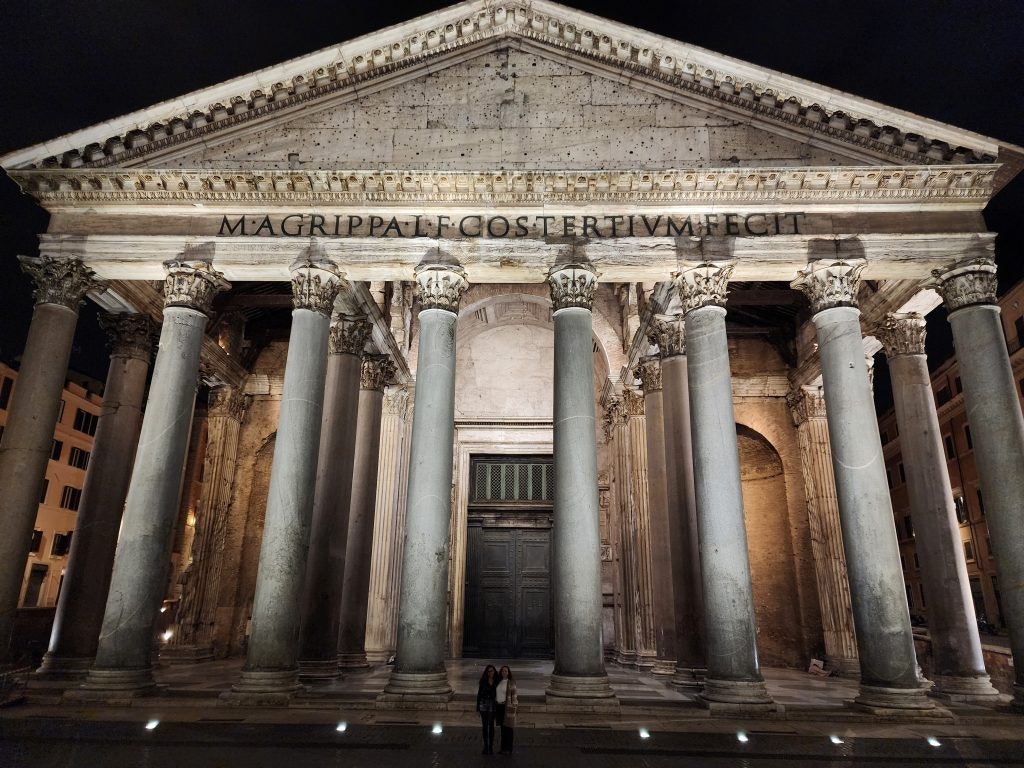
The Pantheon
Palazzo Barberini, Rome
Palazzo Barberini is a Baroque palace in Rome, Italy that houses the Galleria Nazionale d’Arte Antica. It is one of Italy’s most important art collections with masterpieces by Caravaggio, Raphael, and Titian. Visitors to Palazzo Barberini can explore both the magnificent art collection and the architectural beauty of the palace itself, making this famous building a key destination in Rome.

Palazzo Barberini
Church of Sant’Agnese in Agone, Rome
The Church of Sant’Agnese in Agone, located in Rome’s Piazza Navona, is one of the city’s most iconic landmarks. Constructed by the Roman Catholic Church in Baroque style, the church is famous for its dome and two bell towers, which dominate the Piazza Navona. As a focal point of this historic square, Sant’Agnese in Agone is a significant site in Rome, the eternal city.
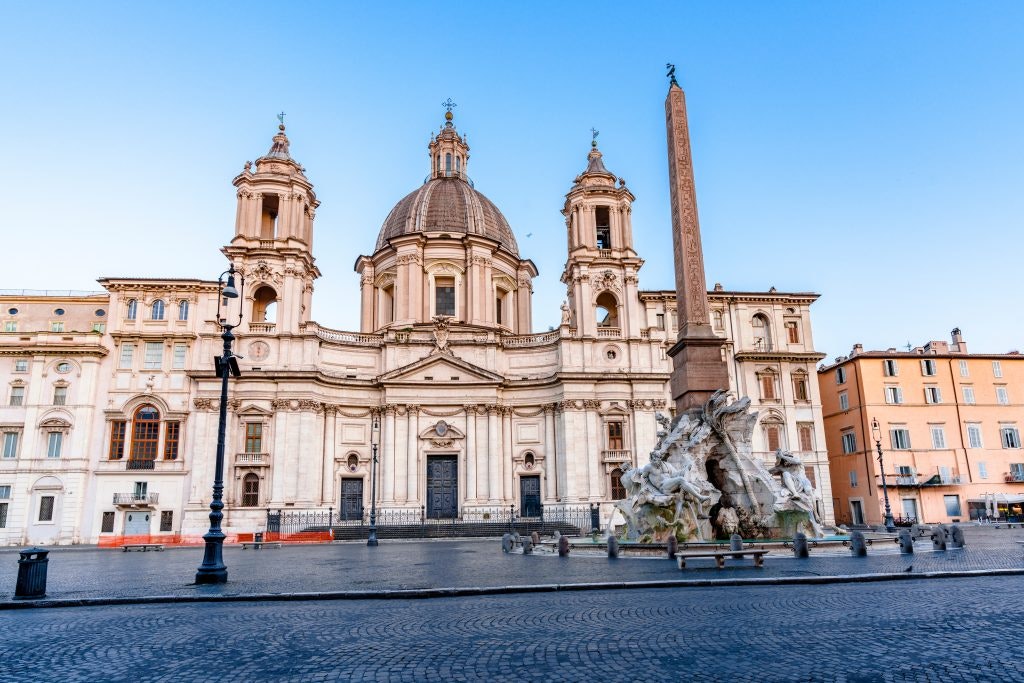
Church of SantAgnese in Agone Rome
St. Peter’s Basilica, Vatican City
St. Peter’s Basilica, located in Vatican City, is one of the world’s most famous cathedrals. Although technically not within Italy, this iconic structure has profoundly shaped Italy’s cultural identity. The basilica’s dome dominates the Vatican City skyline, making it the most recognizable building in the microstate. While St. Peter’s Basilica is renowned worldwide, it is not the Pope’s residence. The Pope actually resides in the Apostolic Palace, also within Vatican City.

Sistine Chapel, Vatican City
Although located in Vatican City and not technically an Italian landmark, the Sistine Chapel is one of the world’s most visited monuments. It is most famous for its breathtaking ceiling, painted by Michelangelo in 1512, which depicts a series of biblical scenes, including the iconic “Creation of Adam.” The Sistine Chapel also serves as the site of the Papal Conclave, where new popes are selected.
![Famous Buildings in Italy: Sistine Chapel]()
Sistine Chapel
Duomo di Siena, Siena Cathedral
The Siena Cathedral is located in the central Siena and stands tall amongst famous Italian buildings for its black-and-white marble stripes and its mosaic floors.
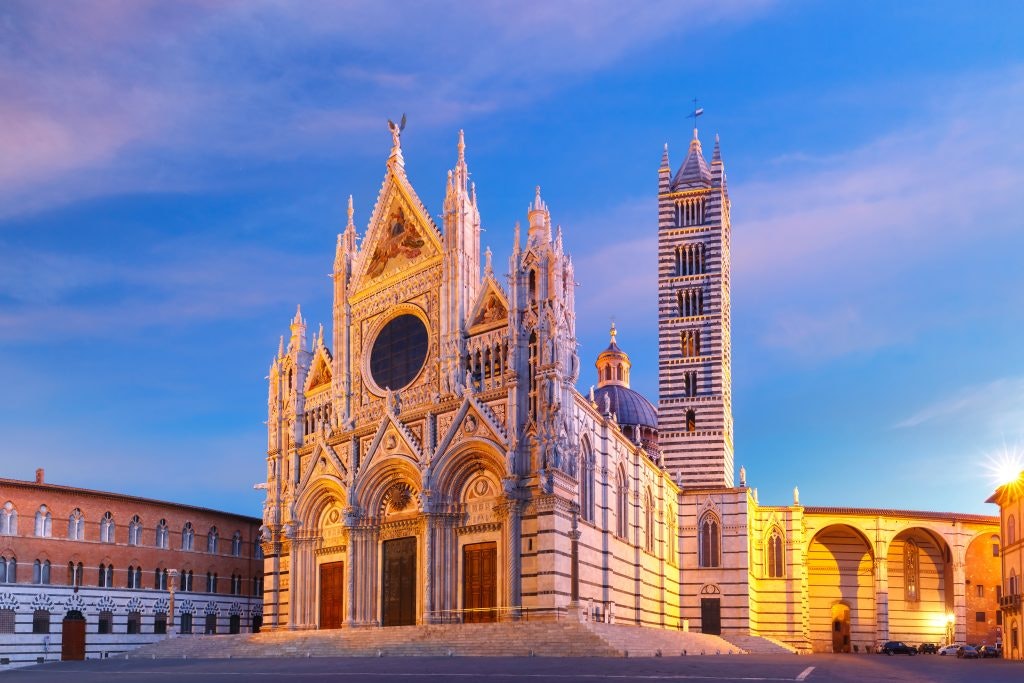
Siena Cathedral or Duomo di Siena, Siena, Tuscany, Italy
Orvieto Cathedral, Umbria
The Orvieto Cathedral, also known as the Duomo di Orvieto, is located in the town of Orvieto in Umbria, Italy. Construction of the Orvieto Cathedral took several centuries, reflecting the evolving artistic styles of the time. The Orvieto Cathedral is best known for its mosaics, bas-reliefs, and statues on the outside that depict biblical scenes and religious themes. The stunning cathedral is one of the best examples of Gothic architecture in Italy and a popular tourist destination.

Orvieto Cathedral exterior
The Uffizi Gallery, Florence
The Uffizi Gallery in Florence is one of the oldest museums in the world. It was started in 1560 for Cosimo I de’ Medici. The Uffizi houses a collection of famous works by Michelangelo, Botticelli, and Leonardo da Vinci. It is one of Italy’s landmarks for art lovers.

The Uffizi gallery on the Arno embankment in Florence, Italy
Florence Cathedral / Piazza del Duomo, Florence
Florence Cathedral, also known as the Duomo di Firenze, is famous for its dome and a blend of Gothic and Renaissance architecture. Located in Piazza del Duomo, the cathedral is named Santa Maria del Fiore, and one of Florence’s most famous landmarks. Visitors should explore Giotto’s Bell Tower, part of the Florence Cathedral complex. Designed by Giotto, the iconic tower offers a panoramic view of the city after you summit the 414 steps.
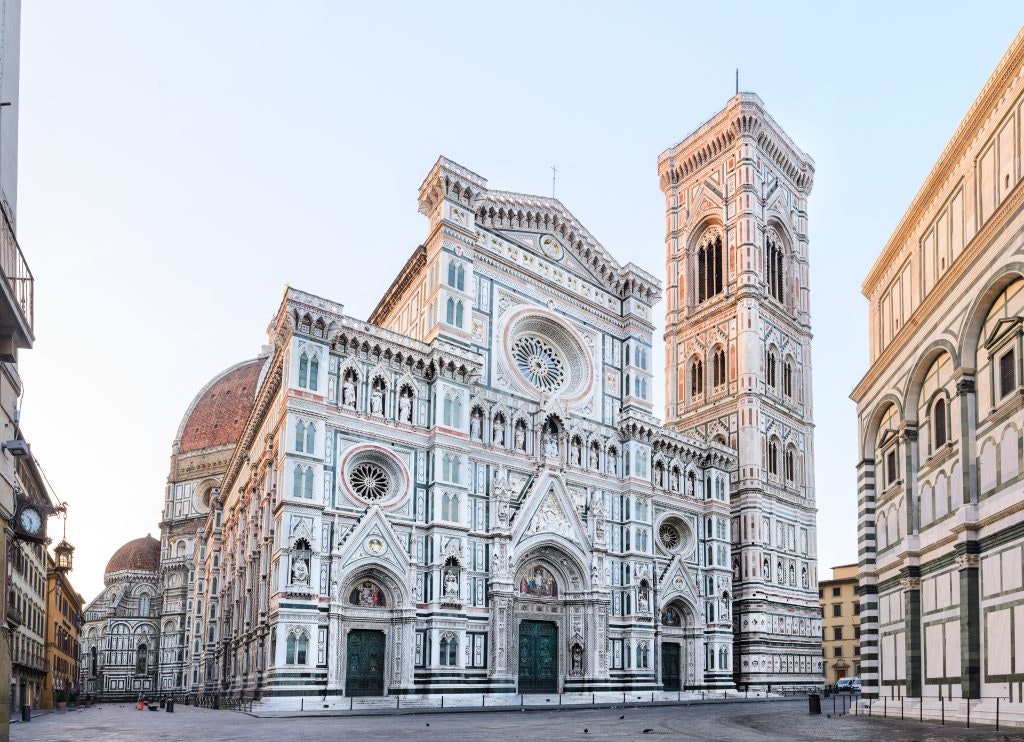
Florence Cathedral (Santa Maria del Fiore), sunrise view in Tuscany, Italy
Palazzo Pitti, Florence
Palazzo Pitti is a royal palace that once served as the seat of the Medici family. The palace has large rooms, big galleries, and vast collections of art and treasure. It is home to several museums, including the Palatine Gallery and the Gallery of Modern Art.

Palazzo Pitti
Palazzo Vecchio, Florence
Palazzo Vecchio is the city’s town hall and a symbol of its rich history and political power. The Torre di Arnolfo dominates the city skyline. Inside the tower, visitors can explore the grand chambers and view Renaissance art.

Palazzo Vecchio Florence, Italy
The Leaning Tower of Pisa, Pisa
The Leaning Tower began leaning right after construction in 1173 because of the shallow foundation on soft soil. Despite its lean, the Leaning Tower is expected to stand for at least another 200 years.
The Leaning Tower of Pisa is part of the Pisa Cathedral complex, also known as the Field of Miracles, a Romanesque architectural masterpiece featuring a stone vaulted roof and intricate designs.
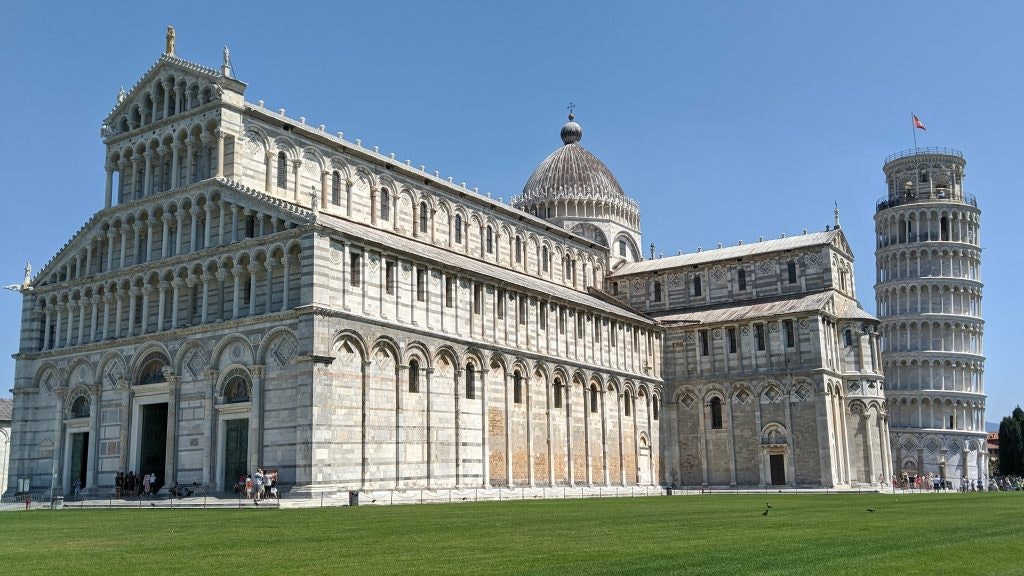
The Pisa Cathedral and the leaning Tower of Pisa
Two Towers, Bologna
Bologna’s Two Towers, known as Due Torri, are iconic symbols of the city. Both towers are leaning, with the taller one named Asinelli and the smaller one called Garisenda. These leaning towers were constructed between 1109 and 1119 and were named after the families who commissioned them.

The Two Towers of Bologna
The churches and mosaics of Ravenna, Ravenna
Ravenna is renowned for its stunning Byzantine architecture and intricate mosaics, particularly in its ancient basilicas and churches, such as the Basilica of San Vitale and the Mausoleum of Galla Placidia. These masterpieces showcase the city’s rich history and are considered some of the finest examples of early Christian art and architecture in the world.

Ravenna Cathedral
Teatro Alla Scala, Milan
Teatro Alla Scala is one of the most famous opera houses in the world. Few buildings match this example of neoclassical mid-18th century architecture, inspired by the classical styles of ancient Rome and Greece.

Teatro Alla Scala – The opera house
Sforzesco Castle, Milan
Sforzesco Castle in Milan was built as a fortress in the 15th century and later transformed into a palace by the Sforza family. Today, the castle is home to an artwork by Michelangelo and Leonardo da Vinci. Sforzesco Castle is one of the most famous medieval castles in Northern Italy.

The Sforza Castle or Castello Sforzesco in Milan, Northern Italy
The Duomo di Milano, Milan
The Duomo di Milano is one of the largest church buildings in the world. Also known as the Milan Cathedral, the building took six centuries to complete. The Milan Cathedral is known for its Gothic architecture, opulence, towering spires, intricate sculptures, and bell towers. The Milan Cathedral is in the heart of Milan’s city center in the Piazza del Duomo.

Milan Cathedral aka Duomo di Milano, Italy
Basilica of Saint Ambrose, Milan
The Basilica of Saint Ambrose in Milan is one of the city’s most important Christian churches. Founded by Saint Ambrose in the 4th century, the basilica is a significant religious landmark, known for its architecture, mosaics, and the tomb of Saint Ambrose himself.

Basilica of Sant’Ambrose
Palazzo della Gran Guardia, Verona
The Palazzo della Gran Guardia in Verona is a grand neoclassical building that serves as a venue for exhibitions, cultural events, and conferences. The Palazzo is in the heart of Verona, and a key cultural heritage landmark in the city.

Palazzo della Gran Guardia
Doge’s Palace, Venice
Doge’s Palace (Palazzo Ducale) in Venice is a prime example of Venetian Gothic architecture. Originally built as a fortified residence for the Doge, the elected leader of the Republic of Venice, the palace now serves as a museum. It memorializes the fascinating history and power of the Venetian Republic.

Doges Palace, Venice, Italy
St. Mark’s Basilica, Venice
St. Mark’s Basilica in Venice was built in the 9th century. Also known as Basilica San Marco, St. Marks is famous for its Byzantine architecture and mosaics.
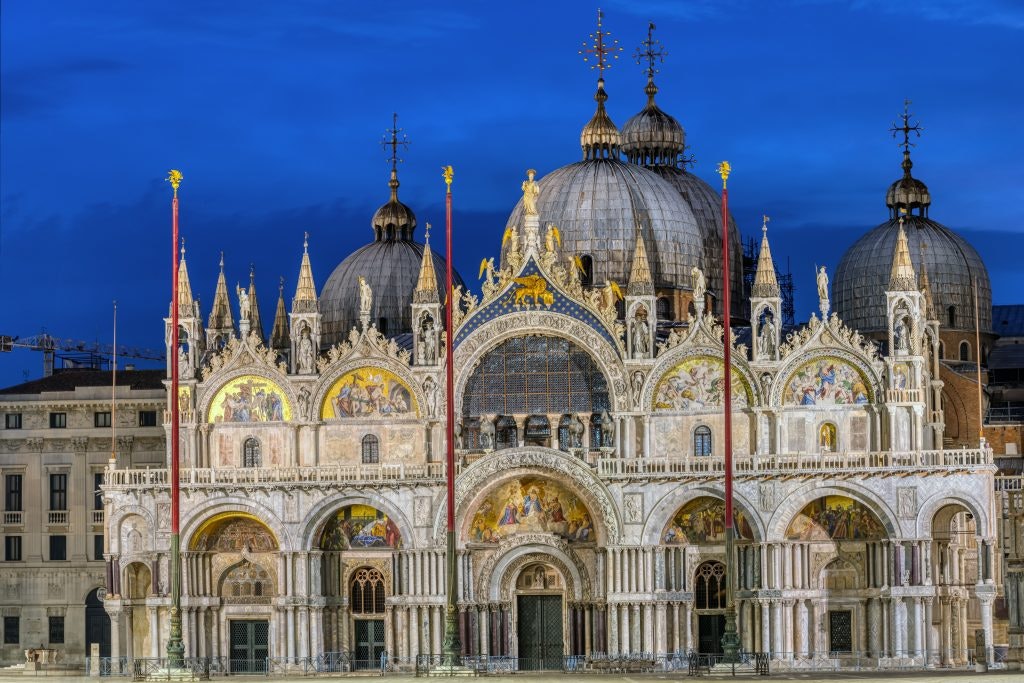
St Mark’s Basilica in Venice
Rialto Bridge, Venice
The Rialto Bridge in Venice is one of the city’s most iconic landmarks, spanning the Grand Canal and serving as a central point for commerce and tourism in Venice. Built in the late 16th century, this stone-arch bridge replaced the previous wooden structures. The Rialto bridge offers great views of the Grand Canal. The Rialto Bridge and the surrounding area are part of Venice’s UNESCO World Heritage sites.
Related: Is Venice Sinking?

Rialto Bridge, Venice
Tips for Visiting Famous Buildings in Italy
- Plan ahead: The popular sites and famous buildings get very crowded. You’ll need to book tickets in advance. Or you can work with www.rusticpathways.com and we can do it for you. Learn more about our Italy programs.
- Dress appropriately: Some religious sites have strict dress codes.
- Explore with intent: Consider guided tours to discover the hidden details.
Read More: The Best Things to Do in Italy





























